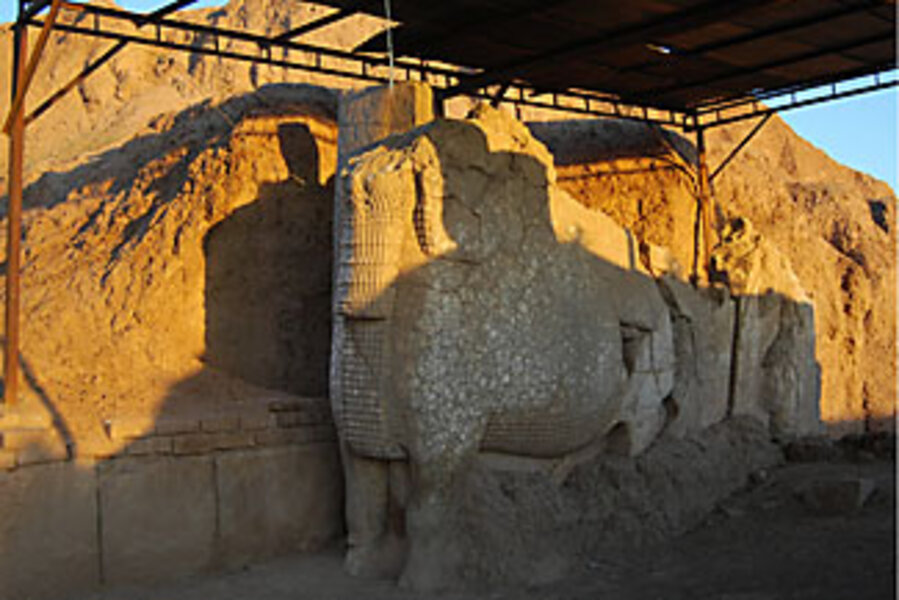Iraq's urban sprawl, not looting, threatens Ninevah antiquities
Loading...
| Mosul, Iraq
Nine-year-old Younis struggles to open the large iron padlock to the gates of Ninevah.
Younis, letting in visitors late one afternoon to the ancient site, is named after the prophet Jonah, who is said to be buried within the city walls of the Assyrian capital. It's a popular name here in the modern city that has sprung up within the ancient walls, threatening the undiscovered layers of civilizations underneath.
"There is very little left of Ninevah now because of the encroachment," says Muzahim Hussein, director of antiquities in Ninevah Province. Mr. Hussein says renovation in the 1990s of the Nebi Younis mosque – dedicated to the prophet Jonah and built on the site of an older church – destroyed part of the ancient city, across the river from modern Mosul.
"There are many treasures under there, but archaeologists could not stop the renovation," says Hussein, who believes there is an Assyrian palace buried underneath the site. "The department of antiquities could not stop the renovations because it was done by President Saddam Hussein himself, and because religiously, it's a holy place and you can't excavate near it or under it."
The Iraqi archaeologist's excavation at Nebi Younis in 1990 revealed neo-Assyrian sculptures that appeared to be the entrance to a palace. Hussein says he wrapped them in plastic and buried them again to hide and protect them.
Conservation experts say that in Ninevah, unlike more remote archaeological sites in southern Iraq, urbanization is more of a threat than looting is. Ninevah was once the most powerful city in the ancient world. In the 7th century BC, the city was the wealthy capital of an empire stretching from the Nile Valley to the Caucasus mountains.
"They're aware of looting and it's a big problem, but all over Iraq and all over the world it's urban sprawl and urban development that threatens sites almost equally," says a US conservation official in Washington, D.C., who has excavated in Ninevah and asked not to be named.
"One of the remarkable things about the northern sites is their scale and their size," says the official. At its height almost 3,000 years ago, the city was thought to have had a population of 100,000 people.
The official says excavations in the late 1980s found evidence of undiscovered settlements more than 30 feet down. Only about 1 percent of the huge site is thought to have been excavated.
Inside the city walls, now on the edge of modern Mosul, farmers are planting crops and grazing sheep. But conservationists say the real damage comes from water and sewer lines dug into the ground as the population increases in the neighborhood of Nebi Younis.
"There are new houses going up and you can see that even as you drive through," says Suzanne Bott, a conservation expert with the US State Department's Provincial Reconstruction Team in Ninevah, adding that people had been paid in the past to move away. "When you get a substructure of water lines and sewer lines with deeper foundations, it becomes much harder to move those people."
What's left of the most-excavated area of Ninevah, the palace of Sennacherib, is deteriorating quickly. At the Nergal gate one of the huge stone statues of a winged bull, unprotected from the elements, is eroding in the blowing sand and rain. Sculptured panels inside are deteriorating because of exposure.
A major British excavation here in the mid-19th century by Henry Austin Layard uncovered 71 halls and chambers of the ancient palace lined with almost two miles of alabaster bas-reliefs depicting great battles and the construction of the palace. The panels were carried away to the British Museum and the Louvre or sold to private collectors. Layard also unearthed the library of Ashurbanipal, containing thousands of clay cuneiform tablets with stories of historical events. Some of the pieces were damaged by looters after 1991 when US-led trade sanctions against Iraq led to poverty and banned other countries from providing cultural assistance to Iraq.
American archaeologist John Russell, who excavated in Ninevah in 1989 and '90, documented the remains of part of the palace. Five years later, stolen fragments of the reliefs he had photographed were appearing for sale in international markets – all had been broken from large panels that had been intact in 1990.
The UN cultural heritage organization UNESCO considers Ninevah among the world's most endangered heritage sites. For archaeologists, it is a wealth of untold stories about the world's first civilizations. "The only thing that will tell us what's there is excavating," says Hussein.





